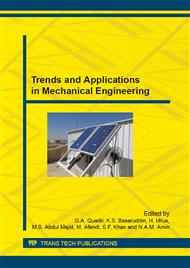p.292
p.300
p.305
p.311
p.318
p.323
p.328
p.334
p.340
Numerical Study of Mold Filling during Encapsulation Process
Abstract:
3-D packaging is a technology that offers high density packaging and high performance. It enables chips to be stack in a single package and widely adopted in multi-media products. Thermosetting material is used for their encapsulation, is flowed through their thin space and wide filling area during package encapsulation process has become vital concern i.e. void formation. In this paper, such issue has been numerical studied due to the effect of transfer speed of the plunger head during encapsulation process. There are five transfer speeds of 1.6, 2.0, 3.4, 6.8, 9.04 mm/s have been chosen in order to investigate the quality of air entrapped (hereafter namely as void), where it degraded the package’s reliability. It is found that the longest transfer speed delivered to the best encapsulation process, which had lowest volume of air trap or void formation in the package.Keywords: Encapsulation, Transfer speed, Vent arrangement, Void Formation
Info:
Periodical:
Pages:
318-322
Citation:
Online since:
August 2015
Keywords:
Price:
Сopyright:
© 2015 Trans Tech Publications Ltd. All Rights Reserved
Share:
Citation:


